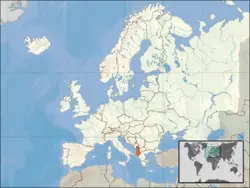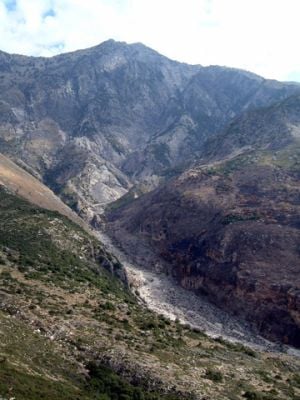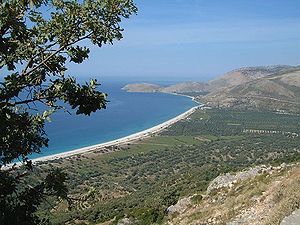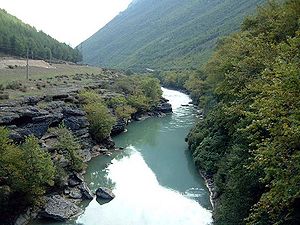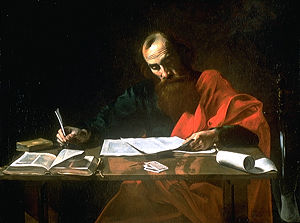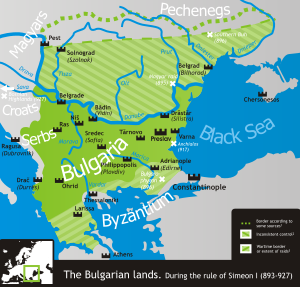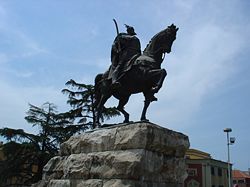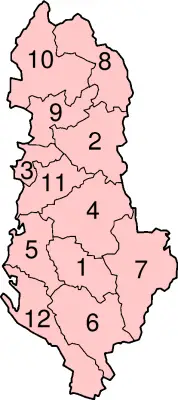Difference between revisions of "Albania" - New World Encyclopedia
Mike Butler (talk | contribs) m |
Mike Butler (talk | contribs) m |
||
| Line 200: | Line 200: | ||
The workforce of Albania has continued to migrate to Greece, Italy, Germany, other parts of Europe, and North America. However, the migration flux is slowly decreasing, as more and more opportunities are emerging in Albania itself as its economy steadily develops. | The workforce of Albania has continued to migrate to Greece, Italy, Germany, other parts of Europe, and North America. However, the migration flux is slowly decreasing, as more and more opportunities are emerging in Albania itself as its economy steadily develops. | ||
| − | == | + | ==Government and politics== |
| − | [[Image:AlbaniaNumberedPrefectures.png| | + | [[Image:AlbaniaNumberedPrefectures.png|300px|thumb|Counties of Albania]] |
| − | + | The Republic of Albania is a parliamentary republic with a democratic constitution that was promulgated in 1998. Political turmoil has continued since the ousting of the authoritarian Berisha regime in 1997, and there is little sign of consensus or cooperation between the ruling and opposition parties. Political tension remained high in 2007. | |
| − | |||
| − | + | The chief of state is the president, who is elected by the People's Assembly for a five-year term (and is eligible for a second term), while the head of government is the prime minister, who is appointed by the president. The Council of Ministers (cabinet) is proposed by the prime minister, nominated by the president, and approved by parliament | |
| − | + | ||
| − | + | A unicameral Assembly, or Kuvendi, comprises 140 seats. One hundred members are elected by direct popular vote and 40 are elected by proportional vote to serve four-year terms. Elections: last held in July 2005. Suffrage is universal for those aged 18 and over. | |
| − | + | ||
| − | + | The judiciary comprises a constitutional court, supreme court (chairman is elected by the People's Assembly for a four-year term), and multiple appeals and district courts. The legal system is based on a civil law system. Albania has not accepted compulsory ICJ jurisdiction, but has accepted jurisdiction of the International Criminal Court for its citizens. | |
| − | + | ||
| − | + | Albania has extensive customary law codified in the Kanun of Lekë Dukagjini. Chapters cover church; the family; marriage; house, livestock, and property; work; transfer of property; the spoken word; honor; damages; crimes; judicial law; and exemptions. This customary law was strictly observed by northern highlands tribes and had priority over all other laws. Some aspects of the Kanun have caused social problems. Vengeance, for instance, was accepted as the main instrument for maintaining justice. This resulted in blood feuds that decimated the northern tribes in the early twentieth century and remains a problem in northern Albania. | |
| − | + | ||
| − | + | Between 1990 and 1992 Albania ended 46 years of xenophobic Communist rule and established a multiparty democracy. The transition has proven challenging as successive governments have tried to deal with high unemployment, widespread corruption, a dilapidated physical infrastructure, powerful organized crime networks, and combative political opponents. | |
| − | + | ||
| − | + | Albania has made progress in its democratic development since first holding multiparty elections in 1991, but deficiencies remain. International observers judged elections to be largely free and fair since the restoration of political stability following the collapse of pyramid schemes in 1997. In the 2005 general elections, the Democratic Party and its allies won a decisive victory on pledges of reducing crime and corruption, promoting economic growth, and decreasing the size of government. The election, and particularly the orderly transition of power, was considered an important step forward. | |
| − | + | ||
| − | + | Albania has played a largely helpful role in managing inter-ethnic tensions in southeastern Europe, and is continuing to work toward joining NATO and the EU. Albania, with troops in Iraq and Afghanistan, has been a strong supporter of the global war on terrorism. | |
| − | + | ||
| − | + | Albania is divided into 12 counties (called ''qark'' or ''prefekturë'' in Albanian). Each county is subdivided into several districts: They are: 1. Berat; 2. Dibër; 3. Durrës; 4. Elbasan; 5. Fier; 6. Gjirokastër; 7. Korçë; 8. Kukës; 9. Lezhë; 10. Shkodër; 11. Tirana; 12. Vlorë. | |
| − | |||
| − | |||
| − | |||
| − | |||
| − | |||
| − | |||
| − | |||
| − | |||
| − | |||
| − | |||
| − | |||
| − | |||
| − | |||
| − | |||
| − | |||
| − | |||
| − | |||
| − | |||
| − | |||
| − | |||
| − | |||
| − | |||
| − | |||
| − | |||
| − | |||
| − | |||
| − | |||
| − | |||
| − | |||
| − | |||
| − | |||
| − | |||
| − | |||
| − | |||
| − | |||
| − | |||
| − | |||
| − | |||
==Demographics== | ==Demographics== | ||
Revision as of 02:06, 20 June 2007
- For the ancient country of Europe in the eastern Caucasus region on the western side of the Caspian Sea, see Caucasian Albania
| Republika e Shqipërisë Republic of Albania | |||||
| |||||
| Anthem: Rreth flamurit të përbashkuar | |||||
| Capital | Tirana 41°20′N 19°48′E | ||||
|---|---|---|---|---|---|
| Largest city | capital | ||||
| Official languages | Albanian | ||||
| Government | Republic | ||||
| - President | Alfred Moisiu | ||||
| - Prime Minister | Sali Berisha | ||||
| Independence | from the Ottoman Empire | ||||
| - Date | November 28 1912 | ||||
| Area | |||||
| - Total | 28 748 km² (139th) 11,100 sq mi | ||||
| - Water (%) | 4.7 | ||||
| Population | |||||
| - (July 2007 est.) estimate | 3,600,523[5] | ||||
| - Density | 123/km² 318.6/sq mi | ||||
| GDP (PPP) | 2007 estimate | ||||
| - Total | $19.818 billion[1] | ||||
| - Per capita | $6,259 | ||||
| HDI (2004) | 0.784 (medium) | ||||
| Currency | Lek (ALL)
| ||||
| Time zone | CET (UTC+1) | ||||
| - Summer (DST) | CEST (UTC+2) | ||||
| Internet TLD | .al | ||||
| Calling code | +355 | ||||
The Republic of Albania (Albanian: Republika e Shqipërisë, IPA [ɾɛˈpubliˌka ɛ ˌʃʨipəˈɾiːs] or simply Shqipëria) is a Balkan country in Southeastern Europe.
Despite its troubled history of foreign rule and dictatorship, the country has been classified as an emerging democracy since the 1990s.
Albania has played a relevant role in managing inter-ethnic tensions in south-eastern Europe and is continuing to work toward joining NATO and the European Union.
Geography
It borders Montenegro to the north, the Serbian province of Kosovo to the northeast, the Republic of Macedonia to the east, and Greece to the south. With the exception of the coastline, all Albanian borders are artificial. They were established in principle at the 1912-1913 conference of ambassadors in London. The northern and eastern borders were intended to separate the Albanians from the Serbs and Montenegrins; the southeast border was to separate Albanians and Greeks; the valuable western Macedonia lake district was to be divided among— Albania, Greece, and Yugoslavia —whose populations shared the area.
It has a coast on the Adriatic Sea to the west and a coast on the Ionian Sea to the southwest. It has a strategic location along Strait of Otranto, that links the Adriatic Sea to Ionian Sea and Mediterranean Sea.
Albania has a total area of 17,864 square miles (28,750 square kilometres), or slightly smaller than the state of Maryland in the United States. Its coastline is 362 kilometres long and stretches on the Adriatic Sea and the Ionian Sea.
The lowlands of the west face the Adriatic Sea. The 70 percent of the country that is mountainous is rugged and often inaccessible. The highest mountain is Mount Korab situated in the district of Dibra, reaching up to 9032 feet (2753 meters).
The country has a mild temperate climate, with cool, cloudy, wet winters and hot, clear, dry summers. The interior is cooler and wetter. The lowlands have mild winters, averaging about 44°F (7°C). Summer temperatures average 75°F (24°C), humidity is high, and the weather tends to be oppressively uncomfortable. Lowland rainfall averages from 40 inches (1000mm) to more than 60 inches (1500mm) annually, with the higher levels in the north. Nearly 95 percent of the rain falls in the winter.
Much of the plain's soil is of poor quality. Far from offering a relief from the difficult interior terrain, the alluvial plain is often as inhospitable as the mountains. Good soil and dependable precipitation, however, are found in intermontane river basins, in the lake district along the eastern frontier, and in a narrow band of slightly elevated land between the coastal plains and the interior mountains.
The three lakes of easternmost Albania, Lake Ohrid (Liqeni Ohrit), Big Prespa Lake (Prespa e Madhe), and Small Prespa Lake (Prespa e Vogël), are remote and picturesque.
The Drin River is the largest and most constant stream. The Semani River and Vjosa River are the only other rivers that are more than 100 miles (160km) long and have basins larger than 1000 square miles (2600 square kilometers). These rivers drain the southern regions and, reflecting the seasonal distribution of rainfall, are torrents in winter and nearly dry in the summer, in spite of their length. With the exception of the Drini i Zi River, which flows northward and drains nearly the entire eastern border region before it turns westward to the sea, most of the rivers in northern and central Albania flow fairly directly westward to the sea.
In its natural state, the coastal belt is characterized by low scrub vegetation, varying from barren to dense. There are large areas of marshlands and other areas of bare, eroded badlands. Where elevations rise slightly and precipitation is regular—in the foothills of the central uplands, for example—the land is highly arable. Marginal land is reclaimed wherever irrigation is possible. and fauna
Natural hazards include destructive earthquakes, tsunamis occur along southwestern coast, floods and drought.
Environmental issues include deforestation, soil erosion, as well as water pollution from industrial and domestic effluents.
Tirana is the capital and largest city of the Republic of Albania. It was founded in 1614 by Sulejman Pasha and became Albania's capital city in 1920. In 2005, its population was officially estimated at 585,756. Other cities are Durrës, Elbasan, Shkodër, Gjirokastër, Vlorë, Korçë and Kukës.
History
The lands that are today inhabited by Albanians were first populated in the Paleolithic Age (Stone Age), over 100,000 years ago. The first areas settled were those with favourable climatic and geographic conditions. In Albania, the earliest settlements have been discovered in the Gajtan cavern (Shkodra), in Konispol, at Mount Dajti, and at Xara (Saranda). Primitive peoples lived in secluded groups, mainly in dry caves. They used stones and bones as their tools. Places such as caverns and lowlands close to rivers were used. In any case, the tools from this age were simple. Paleolithic peoples gathered fruits from plants and hunted wild animals.
The population of Albanian lands increased in the Neolithic age (c. 8000 B.C.E.), marked by the rise of farming. People began to abandon caverns and settle in open areas. Neolithic people were more prone to build their settlements in open fields or next to rivers. A number of such settlements are discovered in Albania, Kosovo, Montenegro, and the Republic of Macedonia.
Pelasgians
The Bronze Age (from the third millennium B.C.E.) brought change. Stockbreeding people came from the east around the mid 3000s B.C.E. to the early 2000s B.C.E. They mixed with the indigenous peoples and thus created the Indo-European peoples of the Balkans. This population is believed to be the ancient Pelasgians, which have been mentioned frequently by ancient writers such as Homer, Herodotus, and Thucydides. The Pelasgians are known as the most ancient inhabitants of the Balkan Peninsula, living before Illyrian or Greek times. Herodotus wrote that Pelasgians dealt with agriculture and the sea, were excellent builders, and built the wall around the Acropolis of Athens, for which they were rewarded with lands in Attica.
Illyrians
The Illyrians were Indo-European tribesmen who appeared in the western portion of the Balkan Peninsula about 1000 B.C.E., a period coinciding with the end of the Bronze Age and beginning of the Iron Age. The Illyrians occupied lands extending from the Danube, Sava, and Morava rivers to the Adriatic Sea and the Sar Mountains. At various times, groups of Illyrians, such as the Messapians and Iapyges, migrated to Italy through both overland routes and the sea.
Corinthian Greek settlers from Corfu established ports on the coast at Apollonia (Pojanë, near modern Vlorë) in 588 B.C.E. and farther north at Lissos (Lezhë) and Epidamnos (modern Durrës) in 623 B.C.E. The Illyrians living in Albania's rugged mountains, however, resisted Greek settlement. Illyrian raiders attacked the coastal cities and Illyrian pirates threatened Greek trading ships in the Adriatic Sea.
The Illyrian king, Bardyllis turned Illyria into a formidable local power in the fourth century B.C.E. In 359 B.C.E., King Perdiccas III of Macedon was killed by attacking Illyrians. But in 358 B.C.E., Macedonia's Philip II, the father of Alexander the Great, defeated the Illyrians and assumed control of their territory as far as Lake Ohrid. Alexander himself routed the forces of the Illyrian chieftain Cleitus in 335 B.C.E., and Illyrian tribal leaders and soldiers accompanied Alexander on his conquest of Persia.
After Alexander's death in 323 B.C.E., independent Illyrian kingdoms again arose. In 312 B.C.E., King Glaukias expelled the Greeks from Durrës. By the end of the third century, the Illyrian king Agron had united many independent cities. Agron made Shkodër his capital and built an army and navy to protect Illyrian cities and ports. His kingdom, which stretched from Dalmatia in the north to the Vijosë River in the south, controlled parts of northern Albania, Montenegro, and Hercegovina. After Agron's death in 231 B.C.E., control of Illyria passed to his widow, Queen Teuta. Under Queen Teuta, Illyrians attacked Roman merchant vessels plying the Adriatic Sea and gave Rome an excuse to invade the Balkans.
Roman rule
In the Illyrian Wars of 229 B.C.E. and 219 B.C.E., Rome overran the Illyrian settlements in the Neretva river valley and suppressed the piracy that had made the Adriatic unsafe. In 180 B.C.E., the Dalmatians declared themselves independent of the Illyrian king Gentius, who kept his capital at Scodra. The Romans defeated Gentius, the last king of Illyria, at Scodra in 168 B.C.E. and captured him, bringing him to Rome in 165 B.C.E. Rome finally subjugated recalcitrant Illyrian tribes in the western Balkans during the reign of Emperor Tiberius in 9 C.E. The Romans divided the lands that constitute modern-day Albania among the provinces of Macedonia, Dalmatia, and Epirus. Four client-republics were set up, which were in fact ruled by Rome. Later, the region was directly governed by Rome and organized as a province.
For about four centuries, Roman rule brought the Illyrian-populated lands economic and cultural advancement and ended most of the enervating clashes among local tribes. The Romans established numerous military camps and colonies and completely latinized the coastal cities. They also oversaw the construction of aqueducts and roads, including the extension of the Via Egnatia, an old Illyrian road and later famous military highway and trade route that led from Durrës through the Shkumbin River valley to Macedonia and Byzantium.
Illyricum was later divided into the provinces of Dalmatia and Pannonia, the lands comprising modern-day Albania mostly being included in the former. Illyrians distinguished themselves as warriors in the Roman legions and made up a significant portion of the Praetorian Guard. Several Roman emperors were of Illyrian origin, including Gaius Decius, Claudius Gothicus, Aurelian, Probus, Diocletian, and Constantine the Great.
Christianity
Christianity came to Illyrian-populated lands in the first century C.E. Saint Paul wrote that he preached in the Roman province of Illyricum, and tradition holds that he visited Durrës. In 379, under emperor Theodosius I, as part of the Prefecture of Illyricum Orientale, the southern region was divided into three provinces: Epirus Vetus, with capital at Nicopolis (modern Preveza), Epirus Nova, with capital at Durrës, and Praevalitania, with capital at Shkodër. Each city formed an archdiocese.
When the Roman Empire was divided into eastern and western halves in 395, Illyria east of the Drinus River (Drina between Bosnia and Serbia), including the lands that now form Albania, were administered by the Eastern Empire but were ecclesiastically dependent on Rome. Within time, much of southern Albania, especially to the east, came to be included within the domain of the Byzantine rite and therefore developed into a branch of the Orthodox Church. In 732, a Byzantine emperor, Leo III the Isaurian, subordinated the area to the patriarchate of Constantinople. For centuries thereafter, the Albanian lands became an arena for the ecclesiastical struggle between Rome and Constantinople. Remaining under Roman influence, most Albanians living in the mountainous north maintained their Roman Catholicism, whereas in the southern and central regions, the majority became Orthodox while forging closer links with Greek peoples to the south.
After the formation of the Slav principality of Dioclia (modern Montenegro), the metropolitan see of Bar was created in 1089, and dioceses in northern Albania (Shkodër, Ulcinj) became its subordinates. Starting in 1019, Albanian dioceses of the Byzantine rite were suffragans of the independent Archdiocese of Ohrid until Durrës and Nicopolis (Preveza) were re-established as metropolitan sees. Thereafter, only the dioceses in inner Albania (Elbasan, Krujë) remained attached to Ohrid. In the 13th century during the Venetian occupation, the Latin Archdiocese of Durrës was founded.
Barbarian invasions
The Germanic Goths and Asiatic Huns were the first to invade; the Avars attacked in 570, and the Slavic Serbs and Croats overran Illyrian-populated areas in the early seventh century. Barbarian tribesmen destroyed the existing social and economic order and leaving the great Roman aqueducts, coliseums, temples, and roads in ruins. The Illyrians gradually disappeared as a distinct people from the Balkans, replaced by the Bulgars, Serbs, Croats, Bosnians and Albanians. In the late Middle Ages, new waves of invaders swept over the Albanian-populated lands.
In the ninth century, the Bulgars conquered much of the Balkan Peninsula and extended their domain to the lowlands of what is now central and southern Albania. The Bulgarian leader Simeon I defeated the Byzantine army and established colonies along the Adriatic seacoast. Samuil, conquered Durrës, the former Roman port of Durrachium that still traded with cities in Greece and Italy. Many Illyrians fled from coastal areas to the mountains, exchanging a sedentary peasant existence for the itinerant life of the herdsman. Other Illyrians intermarried with the conquerors and eventually assimilated.
But the Byzantine emperor Basil II, nicknamed the “Bulgar-slayer”, counterattacked in 1014. The Byzantine forces smashed the Bulgarian army, seized the Adriatic ports, and conquered Epirus, which lies south of Albania. These territories were far from the Byzantine capital at Constantinople, however, and Byzantine authority in the area gradually weakened. While the clans and landowners controlled the countryside, the people of the coastal cities fought against Byzantine rule. It was during this period of rebellion and turmoil that the region first came to be known as Albania.
Late middle ages
The first historical mention of Albania and the Albanians appears in an account of the resistance by a Byzantine emperor, Alexius I Comnenus, to an offensive by the Vatican-backed Normans from southern Italy into the Albanian-populated lands in 1081. In the same year, the weakness of the Byzantine empire let northern Albania slip under Serbian control.
The ports of Albania remained a valuable prize for several rival nations. The Normans, who ruled a kingdom in southern Italy, conquered Durrës in 1081. The Byzantine reconquest of 1083 required the help of Venice, which soon gained commercial privileges in Albanian towns as a reward. This wealthy trading city in northern Italy built fortresses and trading posts in Albania's lowlands to bolster its power. The Normans returned in 1107 and again in 1185 but were quickly expelled.
Norman, Venetian, and Byzantine fleets attacked by sea. Bulgar, Serb, and Byzantine forces came overland and held the region for years. Clashes between rival clans and intrusions by the Serbs produced hardship that triggered an exodus from the region southward into Greece, including Thessaly, the Peloponnese, and the Aegean Islands.
Divided into warring clans, the Albanians were unable to prevent the occupation of their country by outsiders. The Serbs occupied parts of northern and eastern Albania toward the end of the twelfth century and conquered Shkodër in the 1180s. In 1204, after Western crusaders sacked Constantinople, Venice won nominal control over central and southern Albania and the Epirus region of northern Greece and took possession of Durrës. A prince from the overthrown Byzantine ruling family, Michael I Komnenos Doukas, made alliances with Albanian chiefs and drove the Venetians from lands that now make up southern Albania and northern Greece, and in 1204 he set up an independent Byzantine principality, the Despotate of Epirus, with Janina (now Ioannina) as its capital. His successor, Theodore, conciliated the Albanian chiefs in 1216, repulsed an attack on Durrës in 1217 by western Crusaders and Venetian ships, and turned his armies eastward before being defeated in 1230 by the revived Bulgarian Empire of Ivan Asen II.
A restored Byzantine Empire smashed Bulgaria in 1246 and pushed to the north Albanian coast, where the Albanian tribes were briefly weaned away from their alliance with the Despotate of Epirus. The Byzantines gained Durrës in 1256 but lost it in 1257 to Manfred, king of the Two Sicilies, who also acquired Vlorë and Berat in 1268. In 1272 his successor, Charles I of Anjou, the ruler of the Kingdom of Naples and Sicily, conquered Durrës and much of central Albania; he called his new domain the Kingdom of Albania that would last until 1336.
In the mid-1300s, Stefan Dusan, a powerful Serbian prince, conquered much of the western Balkans, including all of Albania except Durrës. Dušan drew up a legal code for his realm and crowned himself "Emperor of the Serbs, Greeks, Bulgarians, and Albanians." But in 1355, while leading an attack against Constantinople, Dušan suddenly died. His empire quickly broke apart, and his lands were divided between Serb and Albanian noblemen.
The constant warfare in Albania caused poverty and deadly famines. Beginning in the fourteenth century, many Albanians left their troubled homeland and migrated southward into the mountains of Epirus and to the cities and islands of Greece. Albanian exiles also built communities in southern Italy and on the island of Sicily.
Ottoman rule
Ottoman supremacy in the Balkan region began in 1385 with the Battle of Savra but was briefly interrupted in the 15th century, when an Albanian warrior known as Skanderbeg, allied with some Albanian chiefs and fought-off Turkish rule from 1443-1478 (although Kastrioti died in 1468). Upon the Ottomans' return, a large number of Albanians fled to Italy, Greece and Egypt. Many Albanians won fame and fortune as soldiers, administrators, and merchants in far-flung parts of the empire. The majority of the Albanian population that remained converted to Islam.
As the centuries passed, however, Ottoman rulers lost the capacity to command the loyalty of local pashas, who governed districts on the empire's fringes, which threatened stability in the region. The Ottoman rulers of the nineteenth century struggled to shore up central authority, introducing reforms aimed at harnessing unruly pashas and checking the spread of nationalist ideas. Albania would be a part of the Ottoman Empire until 1912.
Birth of nationalism
By the 1870s, the image of the "Turkish yoke" had become fixed in the nationalist mythologies of the Balkan peoples. The Albanians, because of the link with Islam and internal social divisions, were the last of the Balkan peoples to want to leave the Ottoman Empire, because they feared that they would lose its Albanian-populated lands to the emerging Balkan states—Serbia, Montenegro, Bulgaria, and Greece.
Albanian leaders formed the League of Prizren in 1878 with the backing of sultan Abdulhamid II, and pressed for territorial autonomy and defending their lands from the onslaught of their neighbours. After decades of unrest an uprising exploded in the Albanian-populated Ottoman territories in 1912, on the eve of the First Balkan War. When Serbia, Montenegro, and Greece laid claim to Albanian lands during the war, the Albanians declared independence.
The European Great Powers endorsed an independent Albania in 1913, after the Second Balkan War. They were assisted by Aubrey Herbert, a British Member of Parliament who passionately advocated their cause in London. As a result, Herbert was offered the crown of Albania, but was dissuaded by the British prime minister, H. H. Asquith, from accepting. Instead the offer went to William of Wied, a German prince who accepted and became sovereign of the new Principality of Albania.
The young state, however, collapsed within weeks of the outbreak of World War I. Before this, Albanians rebelled against the German prince and declared the independence of their country from the jurisdiction of the great powers and established throughout the country a Muslim regime under the leadership of a local warrior, Haji Qamil.
World War I
Albania achieved a degree of statehood after World War I, in part because of the diplomatic intercession of the United States. The country suffered from a debilitating lack of economic and social development, however, and its first years of independence were fraught with political instability. Unable to find strength without a foreign protector, Albania became the object of tensions between Italy and the Kingdom of the Serbs, Croats, and Slovenes (the later Socialist Federal Republic of Yugoslavia), which both sought to dominate the country.
With Yugoslav military assistance, Ahmed Bey Zogu, the son of a clan chieftain, emerged victorious from an internal political power struggle in late 1924. Under him, Albania joined the Italian coalition of Kingdom of Italy, Hungary, Romania and Bulgaria against Yugoslavia in 1924-1927. After the United Kingdom's and France's political intervention in 1927 with the Kingdom of Yugoslavia, the alliance crumbled. In 1928 the country's parliament declared Albania a kingdom and Zogu king. King Zog remained a conservative, introduced the European style of life, and initiated reforms, for example, in an attempt at social modernisation the custom of adding one's region to one's name was dropped. Zog also made donations of land to international organisations for the building of schools and hospitals. Mussolini's forces overthrew King Zog when they occupied Albania in 1939. After the fall of the communist government, his son Leka, Crown Prince of Albania and the royal family returned to Albania on June 28 2002.
The Second World War
Italy invaded Albania on 7 April, 1939, meeting little resistance, and took control of the country. During this time, the Italians annexed parts of Montenegro, Kosovo and Northern Greece to the country. This led to an ironic situation for the nationalists: although the country was occupied, the dream of an Ethnic Albania was realized. Albanian communists and nationalists actively fought a partisan war against the Italian and German invasions in World War II. The socialists (most often called communists) took over after World War II. In November 1944, the communists gained control of the government under the leader of the resistance, Enver Hoxha. The Communist Party was created on November 8, 1941, with the help of Bolshevik Communist Parties, under the guidance of the Communist Party of Yugoslavia.
Totalitarian state
For the many decades under his totalitarian domination, Hoxha created and destroyed relationships with Yugoslavia, the Soviet Union, and China. Towards the end of the Hoxha era, Albania was isolated, first from the capitalist West (Western Europe, North America and Australia) and later even from the communist East. Enver Hoxha died in 1985. There are statistics that show that during this period about 6000 Albanian citizens were executed for political reasons. Despite this, the quality of life improved as both life expectancy and literacy showed large gains and economic growth continued until the mid 1970s.
In the mid-1960s, Albania's leaders grew wary of a threat to their power by a growing bureaucracy. Party discipline had eroded. People complained about official wrong-doing, inflation, and low-quality goods. Writers strayed from socialist realism, which demanded that art and literature serve as instruments of party policy. After Mao Zedong unleashed the Cultural Revolution in China in 1966, Hoxha launched his own cultural and ideological revolution. The Albanian leader concentrated on reforming the military, government bureaucracy, and economy as well as on creating new support for his Stalinist system. The regime abolished military ranks, reintroduced political commissars into the military, and renounced professionalism in the army. Railing against a "white-collar mentality," the authorities also slashed the salaries of mid- and high-level officials, ousted administrators and specialists from their desk jobs, and sent such persons to toil in the factories and fields. Six ministries, including the Ministry of Justice, were eliminated. Farm collectivization spread to even the remote mountains. The government attacked dissident writers and artists, reformed its education system, and generally reinforced Albania's isolation from European culture in an effort to keep out foreign influences.
In 1967 the authorities conducted a violent campaign to extinguish religious life, claiming that religion had divided the Albanian nation and kept it mired in backwardness. Student agitators combed the countryside, forcing Albanians to quit practicing their faith. Despite complaints, all churches, mosques, monasteries, and other religious institutions had been closed or converted into warehouses, gymnasiums, and workshops by year's end. The campaign culminated in an announcement that Albania had become the world's first atheistic state, a feat touted as one of Enver Hoxha's greatest achievements.
Traditional kinship links in Albania, centered on the patriarchal family, were shattered by the postwar repression of clan leaders, collectivization of agriculture, industrialization, migration from the countryside to urban areas, and suppression of religion. The postwar regime brought a radical change in the status of Albania's women. Considered second-class citizens in traditional Albanian society, women performed most of the work at home and in the fields. Before World War II, about 90 percent of Albania's women were illiterate, and in many areas they were regarded as chattels under ancient tribal laws and customs. During the cultural and ideological revolution, the party encouraged women to take jobs outside the home in an effort to compensate for labor shortages and to overcome their conservatism. Hoxha himself proclaimed that anyone who trampled on the party's edict on women's rights should be "hurled into the fire."
The rise of democracy
The first massive anti-communist protests took place in July 1990. Shortly afterwards, the communist regime under Ramiz Alia carried out some cosmetic changes in the economy. At the end of 1990, after strong student protests and independent syndicated movements, the regime accepted a multiparty system. The first pluralist general elections were held on March 31, 1991, and saw the Communist Party (PPSH) win the majority. Democratic parties accused the government of manipulation and called for new elections, which were held on March 22, 1992, and resulted in a democratic coalition (composed of the Democratic Party, the Social-Democrats, and the Republican Party) coming to power.
In the general elections of June 1996 the Democratic Party won an absolute majority and the results winning over 85 percent of parliamentary seats. In 1997 widespread riots erupted after the International Monetary Fund forced the state to liberalise banking practices. Many citizens, naive to the workings of a market economy, put their entire savings into pyramid schemes. In a short while, $2-billion (80 percent of the country's GDP) had been moved into the hands of just a few pyramid scheme owners, causing severe economic troubles and civic unrest. Police stations and military bases were looted of millions of Kalashnikovs and other weapons. Anarchy prevailed, and militia and even less-organized armed citizens controlled many cities. Even American military advisors left the country for their own safety. The government of Aleksander Meksi resigned and a government of national unity was built. In response to the anarchy, the Socialist Party won the early elections of 1997 and Berisha resigned the Presidency.
However, stability was far from being restored in the years after the 1997 riots. The power feuds raging inside the Socialist Party led to a series of short-lived Socialist governments. The country was flooded with refugees from neighboring Kosovo in 1998 and 1999 during the Kosovo War. In June 2002, a compromise candidate, Alfred Moisiu, a former general, was elected to succeed President Rexhep Meidani. Parliamentary elections in July 2005 brought Sali Berisha, as leader of the Democratic Party, back to power, mostly owing to Socialist infighting and a series of corruption scandals plaguing the government of Fatos Nano.
The Euro-Atlantic integration of Albania has been the ultimate goal of the post-communist governments. Albania's European Union membership bid has been set as a priority by the European Commission. On 2006 Albania signed a Stabilization and Association Agreement the EU, thus completing the first major step towards joining the bloc. Albania, along with Croatia and Macedonia, is also expected to receive an invitation to join NATO in 2008.
The workforce of Albania has continued to migrate to Greece, Italy, Germany, other parts of Europe, and North America. However, the migration flux is slowly decreasing, as more and more opportunities are emerging in Albania itself as its economy steadily develops.
Government and politics
The Republic of Albania is a parliamentary republic with a democratic constitution that was promulgated in 1998. Political turmoil has continued since the ousting of the authoritarian Berisha regime in 1997, and there is little sign of consensus or cooperation between the ruling and opposition parties. Political tension remained high in 2007.
The chief of state is the president, who is elected by the People's Assembly for a five-year term (and is eligible for a second term), while the head of government is the prime minister, who is appointed by the president. The Council of Ministers (cabinet) is proposed by the prime minister, nominated by the president, and approved by parliament
A unicameral Assembly, or Kuvendi, comprises 140 seats. One hundred members are elected by direct popular vote and 40 are elected by proportional vote to serve four-year terms. Elections: last held in July 2005. Suffrage is universal for those aged 18 and over.
The judiciary comprises a constitutional court, supreme court (chairman is elected by the People's Assembly for a four-year term), and multiple appeals and district courts. The legal system is based on a civil law system. Albania has not accepted compulsory ICJ jurisdiction, but has accepted jurisdiction of the International Criminal Court for its citizens.
Albania has extensive customary law codified in the Kanun of Lekë Dukagjini. Chapters cover church; the family; marriage; house, livestock, and property; work; transfer of property; the spoken word; honor; damages; crimes; judicial law; and exemptions. This customary law was strictly observed by northern highlands tribes and had priority over all other laws. Some aspects of the Kanun have caused social problems. Vengeance, for instance, was accepted as the main instrument for maintaining justice. This resulted in blood feuds that decimated the northern tribes in the early twentieth century and remains a problem in northern Albania.
Between 1990 and 1992 Albania ended 46 years of xenophobic Communist rule and established a multiparty democracy. The transition has proven challenging as successive governments have tried to deal with high unemployment, widespread corruption, a dilapidated physical infrastructure, powerful organized crime networks, and combative political opponents.
Albania has made progress in its democratic development since first holding multiparty elections in 1991, but deficiencies remain. International observers judged elections to be largely free and fair since the restoration of political stability following the collapse of pyramid schemes in 1997. In the 2005 general elections, the Democratic Party and its allies won a decisive victory on pledges of reducing crime and corruption, promoting economic growth, and decreasing the size of government. The election, and particularly the orderly transition of power, was considered an important step forward.
Albania has played a largely helpful role in managing inter-ethnic tensions in southeastern Europe, and is continuing to work toward joining NATO and the EU. Albania, with troops in Iraq and Afghanistan, has been a strong supporter of the global war on terrorism.
Albania is divided into 12 counties (called qark or prefekturë in Albanian). Each county is subdivided into several districts: They are: 1. Berat; 2. Dibër; 3. Durrës; 4. Elbasan; 5. Fier; 6. Gjirokastër; 7. Korçë; 8. Kukës; 9. Lezhë; 10. Shkodër; 11. Tirana; 12. Vlorë.
Demographics
95% of the population are ethnic Albanians. The 5% minorities include Greeks, Macedonians (ethnic group), Roma (Gypsies), Egyptians (Balkans), Vlachs and Italians. The dominant language is Albanian, with two main dialects, Gheg and Tosk. Many Albanians are also fluent in English, Greek, Italian and French.
As a part of the Ottoman Empire, Albania became a mostly Muslim (see Islam in Albania) territory. During the communist regime, religion was officially banned, and Albania was proclaimed as the first and only Atheist state in the world. Today, with the freedom of religion and worship, Albania contains numerous religions and denominations; however, within a muslim majority that may amount to 75% of the total population.[2][3][4][5] Other main religions of the world also have some small representation in Albania. Religious fanaticism has never been a problem,[6] with people from different religious groups living in peace. Interreligious marriage is very common, and an immensely strong sense of Albanian identity has tended to bind Albanians of all religious practices together.[7]
Economy
Since the fall of communism in 1990, Albania has launched economic programmes towards a more open-market economy[citation needed]. The democratically elected government that assumed office in April 1992 launched an ambitious economic reform programme to halt economic deterioration and put the country on the path toward a market economy[citation needed]. Key elements included price and exchange system liberalisation, fiscal consolidation, monetary restraint, and a firm income policy[citation needed]. These were complemented by a comprehensive package of structural reforms, including privatisation, enterprise, and financial sector reform, and creation of the legal framework for a market economy and private sector activity. Most prices were liberalised and are now approaching levels typical of the region[citation needed]. Most agriculture, state housing, and small industry were privatised, along with transportation, services, and small and medium-sized enterprises[citation needed]. After severe economic contraction following 1989, the economy slowly rebounded, finally surpassing its 1989 levels by the end of the 1990s. GDP per capita. Since prices have also risen, however, economic hardship has continued for much of the population. In 1995, Albania began privatizing large state enterprises. Since 2000, Albania has experienced a more rapid expansion of its economy.[citation needed]
Following the signing of the Stabilisation and Association Agreement in June/July 2006, EU ministers urged Albania to push ahead with reforms, focusing on press freedom, property rights, institution building, respect for ethnic minorities and observing international standards in municipal elections.
Albania's coastline on the Ionian Sea, especially near the Greek tourist island of Corfu, is becoming increasingly popular with tourists due to its relatively unspoiled nature and its beaches. The tourism industry is growing rapidly.
Notes and references
This article contains material from the Library of Congress Country Studies, which are United States government publications in the public domain.
This article contains material from the CIA World Factbook which, as a U.S. government publication, is in the public domain.
- ↑ Source for Albania GDP information IMF Albania Data
- ↑ US Department of State - International Religious Freedom Report 2006 - [1]
- ↑ L'Albanie en 2005 - [2]
- ↑ Zuckerman, Phil. "Atheism: Contemporary Rates and Patterns ", chapter in The Cambridge Companion to Atheism, ed. by Michael Martin, Cambridge University Press: Cambridge, UK (2005) [3]
- ↑ Goring, Rosemary (ed). Larousse Dictionary of Beliefs & Religions (Larousse: 1994); pg. 581-584. Table: "Population Distribution of Major Beliefs" [4]
- ↑ http://www.state.gov/g/drl/rls/irf/2004/35434.htm
- ↑ http://www.britannica.com/eb/article-42625
See also
|
|
|
|
- Lists
- List of Albania-related articles
- List of Albanians
- List of Albanian writers
- List of Albanian-Americans
External links
 Wikimedia Atlas of Albania, holding maps related to Albania.
Wikimedia Atlas of Albania, holding maps related to Albania.- Presidency of Albania
- The Albanian Parliament
- Albanian Institute of Statistics
- Department of Information
- Links to governmental sites
- OPIC Guide on Albania
- CIA World Factbook entry on Albania
- National Tourism Organization Albania's official website for travel & tourism information.
- Travel guide to Albania from Wikitravel
- Albania travel guide Bradt Travel Guides
- VIVAlbania, hospitality and ecotourism in Albania
- Tourism, Krujë
- Treasure of the national library of Albania
Credits
New World Encyclopedia writers and editors rewrote and completed the Wikipedia article in accordance with New World Encyclopedia standards. This article abides by terms of the Creative Commons CC-by-sa 3.0 License (CC-by-sa), which may be used and disseminated with proper attribution. Credit is due under the terms of this license that can reference both the New World Encyclopedia contributors and the selfless volunteer contributors of the Wikimedia Foundation. To cite this article click here for a list of acceptable citing formats.The history of earlier contributions by wikipedians is accessible to researchers here:
The history of this article since it was imported to New World Encyclopedia:
Note: Some restrictions may apply to use of individual images which are separately licensed.


